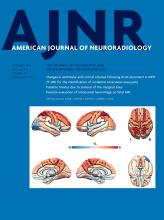Index by author
Elder, B.D.
- EDITOR'S CHOICEAdult BrainYou have accessChanges in Ventricular and Cortical Volumes following Shunt Placement in Patients with Idiopathic Normal Pressure HydrocephalusP.M. Cogswell, M.C. Murphy, M.L. Senjem, H. Botha, J.L. Gunter, B.D. Elder, J. Graff-Radford, D.T. Jones, J.K. Cutsforth-Gregory, C.G. Schwarz, F.B. Meyer, J. Huston and C.R. JackAmerican Journal of Neuroradiology December 2021, 42 (12) 2165-2171; DOI: https://doi.org/10.3174/ajnr.A7323
Overall, cortical volumes mildly increased after shunt placement in patients with idiopathic normal pressure hydrocephalus with the greatest increases in regions near the vertex, indicating postshunt decompression of the cortex and sulci.
Eliezer, M.
- EDITOR'S CHOICENeurointerventionYou have accessPulsatile Tinnitus Due to Stenosis of the Marginal Sinus: Diagnosis and Endovascular TreatmentJ. Cortese, M. Eliezer, A. Guédon and E. HoudartAmerican Journal of Neuroradiology December 2021, 42 (12) 2194-2198; DOI: https://doi.org/10.3174/ajnr.A7325
Marginal sinus stenosis is a novel cause of venous pulsatile tinnitus, which can be easily detected on MR imaging. Marginal sinus stent placement is safe and efficient.
Ellison, D.W.
- Pediatric NeuroimagingOpen AccessAnatomic Neuroimaging Characteristics of Posterior Fossa Type A Ependymoma SubgroupsN.D. Sabin, S.N. Hwang, P. Klimo, N. Chambwe, R.G. Tatevossian, T. Patni, Y. Li, F.A. Boop, E. Anderson, A. Gajjar, T.E. Merchant and D.W. EllisonAmerican Journal of Neuroradiology December 2021, 42 (12) 2245-2250; DOI: https://doi.org/10.3174/ajnr.A7322
Engelbart, J.M.
- FELLOWS' JOURNAL CLUBSpine Imaging and Spine Image-Guided InterventionsYou have accessAccuracy and Clinical Utility of Reports from Outside Hospitals for CT of the Cervical Spine in Blunt TraumaK. Rao, J.M. Engelbart, J. Yanik, J. Hall, S. Swenson, B. Policeni, J. Maley, C. Galet, T. Granchi and D.A. SkeeteAmerican Journal of Neuroradiology December 2021, 42 (12) 2254-2260; DOI: https://doi.org/10.3174/ajnr.A7337
There was an overall 6.5% discordance rate between primary and secondary interpretations of cervical spine CT scans. The secondary interpretation of the cervical spine CT increased the sensitivity and specificity of detecting cervical spine fractures in patients with blunt trauma transferred to higher-level care.
Epstein, K.N.
- FELLOWS' JOURNAL CLUBPediatric NeuroimagingYou have accessPrenatal Evaluation of Intracranial Hemorrhage on Fetal MRI: A Retrospective ReviewK.N. Epstein, B.M. Kline-Fath, B. Zhang, C. Venkatesan, M. Habli, D. Dowd and U.D. NagarajAmerican Journal of Neuroradiology December 2021, 42 (12) 2222-2228; DOI: https://doi.org/10.3174/ajnr.A7320
The EPI blood sequence is the most sensitive in the identification of fetal intracranial hemorrhage, which, in conjunction with T2-SSFSE images, can optimize classification and subsequent grading of germinal matrix hemorrhages in the fetus. The authors report a significant increase in neonatal death in the non-GMH-versus-GMH group and worsened brain parenchymal findings in more severe GMH grades (III-IV) on postnatal MR imaging.
Erturk, S.M.
- Head and Neck ImagingOpen AccessQuantitative Analysis of the Olfactory System in COVID-19: An MR Imaging StudyE. Altunisik, A.H. Baykan, S. Sahin, E. Aydin and S.M. ErturkAmerican Journal of Neuroradiology December 2021, 42 (12) 2207-2214; DOI: https://doi.org/10.3174/ajnr.A7278








